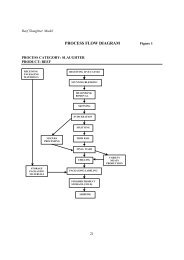Write down what went wrong and what you did about it in your diary.
Write down what went wrong and what you did about it in your diary.
Write down what went wrong and what you did about it in your diary.
You also want an ePaper? Increase the reach of your titles
YUMPU automatically turns print PDFs into web optimized ePapers that Google loves.
Type of foodShellfishSoyaGlutenSesameseedsCeleryMustardSulphurdioxideWhat to look forPeople who are allergic to shellfish often need to avoid all types, <strong>in</strong>clud<strong>in</strong>gscampi, prawns, mussels <strong>and</strong> crab. Watch out for shrimp paste <strong>and</strong> oyster sauce<strong>in</strong> Ch<strong>in</strong>ese <strong>and</strong> Thai dishes.Soya comes <strong>in</strong> different forms, for example, tofu (or beancurd), soya flour <strong>and</strong>textured soya prote<strong>in</strong>. It is found <strong>in</strong> many foods, <strong>in</strong>clud<strong>in</strong>g ice cream, sauces,desserts, meat products <strong>and</strong> vegetarian products such as ‘veggie burgers’.People who have gluten <strong>in</strong>tolerance (also called Coeliac disease) need to avoidcereals such as wheat, rye <strong>and</strong> barley, <strong>and</strong> foods made from these. Wheat flouris used <strong>in</strong> many foods such as bread, pasta, cakes, pastry <strong>and</strong> meat products.Watch out for soups <strong>and</strong> sauces thickened w<strong>it</strong>h flour, foods that are dustedw<strong>it</strong>h flour before cook<strong>in</strong>g, batter <strong>and</strong> breadcrumbs.Sesame seeds are often used on bread <strong>and</strong> breadsticks. Sesame paste (tah<strong>in</strong>i) isused <strong>in</strong> some Greek <strong>and</strong> Turkish dishes, <strong>in</strong>clud<strong>in</strong>g houmous. Watch out forsesame oil used for cook<strong>in</strong>g or <strong>in</strong> dress<strong>in</strong>gs.People who are allergic to celery can react to celeriac (the root of the plant)<strong>and</strong> celery stalks <strong>and</strong> leaves. Celeriac <strong>and</strong> celery are sometimes used as an<strong>in</strong>gredient <strong>in</strong> salads <strong>and</strong> soups, or served as a vegetable. Watch out for celerysalt, which is used as a season<strong>in</strong>g <strong>in</strong> lots of foods, such as soups <strong>and</strong> meatproducts. Also look out for celery seeds, which are used as a spice.People who are allergic to mustard will react to any food that comes from themustard plant, <strong>in</strong>clud<strong>in</strong>g liquid mustard, mustard powder, the leaves, seeds <strong>and</strong>flowers, sprouted mustard seeds <strong>and</strong> mustard oil. Mustard is sometimes used <strong>in</strong>salad dress<strong>in</strong>gs, mar<strong>in</strong>ades, soups, sauces, curries <strong>and</strong> meat products.Some people w<strong>it</strong>h asthma can react to sulphur dioxide. This is used as apreservative <strong>in</strong> a wide range of foods, particularly meat products such assausages, soft dr<strong>in</strong>ks, <strong>and</strong> dried fru<strong>it</strong> <strong>and</strong> vegetables. Sulphur dioxide is alsofound <strong>in</strong> w<strong>in</strong>e <strong>and</strong> beer.What to do if th<strong>in</strong>gs go <strong>wrong</strong>If <strong>you</strong> th<strong>in</strong>k a customer is hav<strong>in</strong>g a severeallergic reaction:• Do not move them.• R<strong>in</strong>g 999 <strong>and</strong> ask for an ambulance w<strong>it</strong>ha paramedic straight away.• Expla<strong>in</strong> that <strong>you</strong>r customer could have anaphylaxis(pronounced ‘anna-fill-axis’).• Send someone outside to wa<strong>it</strong> for the ambulance.How to stop this happen<strong>in</strong>g aga<strong>in</strong>• Make sure that all <strong>you</strong>r staff underst<strong>and</strong> howimportant <strong>it</strong> is to check all the contents of adish if they are asked by someone who hasa food allergy.• Make sure <strong>you</strong> are keep<strong>in</strong>g <strong>in</strong>gredient <strong>in</strong>formationfor all ready-made products <strong>and</strong> that staff knowto check this.• Review the way that staff prepare a dish forsomeone w<strong>it</strong>h a food allergy – are they clean<strong>in</strong>geffectively first <strong>and</strong> us<strong>in</strong>g clean equipment?• Improve the descriptions on <strong>you</strong>r menu.• Tra<strong>in</strong> staff aga<strong>in</strong> on this safe method.• Improve supervision.Diary<strong>Wr<strong>it</strong>e</strong> <strong>down</strong> <strong>what</strong> <strong>went</strong> <strong>wrong</strong> <strong>and</strong> <strong>what</strong> <strong>you</strong> <strong>did</strong> <strong>about</strong> <strong>it</strong> <strong>in</strong> <strong>you</strong>r <strong>diary</strong>.DiaryCC7/09-06











